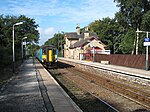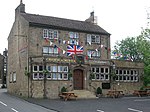Chapel-en-le-Frith

Chapel-en-le-Frith () is a town and civil parish in the Borough of High Peak in Derbyshire, England. It has been dubbed the "Capital of the Peak", in reference to the Peak District, historically the highland areas between the Saxon lands (below the River Trent) and the Vikings lands (which came as far south as Dore, Sheffield). The town was established by the Normans in the 12th century, originally as a hunting lodge within the Forest of High Peak. This led to the Anglo-Norman-derived name Chapel-en-le-Frith ("chapel in the forest"). (It appears in a Middle English form in a Latin record as Chapell in the ffryth, in 1401.) The population at the 2011 census was 8,635.
Excerpt from the Wikipedia article Chapel-en-le-Frith (License: CC BY-SA 3.0, Authors, Images).Chapel-en-le-Frith
Bowling Green Lane, High Peak Chapel-en-le-Frith
Geographical coordinates (GPS) Address Nearby Places Show on map
Geographical coordinates (GPS)
| Latitude | Longitude |
|---|---|
| N 53.322 ° | E -1.917 ° |
Address
Bowling Green Lane
Bowling Green Lane
SK23 0HR High Peak, Chapel-en-le-Frith
England, United Kingdom
Open on Google Maps











